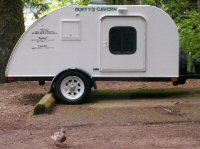troubleScottie wrote:Generally all the chargers ( solar controller and AC 12V power supply) are connected directly to the batteries. All DC power then comes from the batteries to your DC fuse box.
The advantage is when you are connected to shore power or generator or solar, any extra capacity goes to the batteries. Of course that makes your DC power source be an intelligent charger, not just a simple converter. Then the transfer switch is unnecessary.
Having a switch to turn off the DC power between your batteries and the DC Load and the inverter is useful especially when in storage or under tow.
You will have to consider the inverter being on a switch or removable from the DC source. Inverters draw power even when no load is applied. Your current scheme (no pun intended) will run down the batteries while under tow.
You may want an AC panel with a circuit breaker for each AC outlet. Depends on your power needs. Some designs just use extension cords and power strips. If you are running air conditioning, then I would encourage a real power panel.
Definitely GFCI outlets inside or outside.
There are different schools of thought on having inverter at all. Most designs only have AC when connected to shore power or generators. Some designs are DC only. There are many devices that are DC including lights, fans, refrigs, televisions, radios, water pumps, water heaters. They typically are more efficient then converting DC to AC for a device. Would carrying one be useful at times, sure.
Thanks for the tips.
My thoughts were to use a transfer switch instead of expensive intelligent charger. This is due to the fact that I would not be using shore power that much, based on where we camp (no power), but wanted the cheapest option to power the DC side from AC power (if available or needed). Now I am thinking that it may be best If I just leave the converter off totally. Just use a battery charger when i do have shore power (which will not be much) and of course run the camper on DC batteries. Then I would not need a transfer switch.
I was wondering about the AC panel, Thanks, I think I will add it just for future options (does not add much cost), mostly for possible future Air conditioning. I do not camp in the summer in the south! But may if I had air conditioning.
Thanks again on the inverter battery drain, that was my thought but was unsure. I was only going to use a 400W inverter in order to charge my computer and camera batteries at night (if needed).




